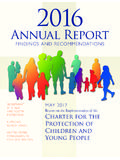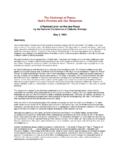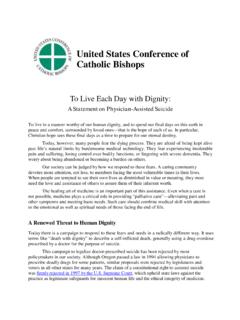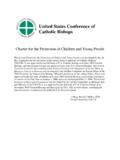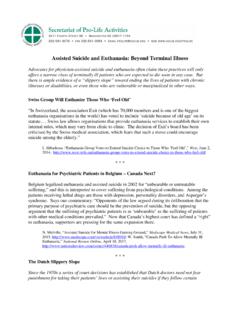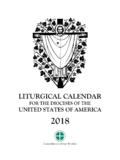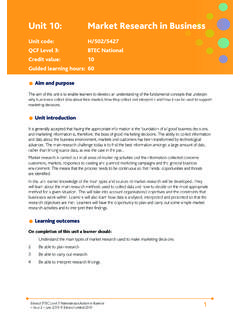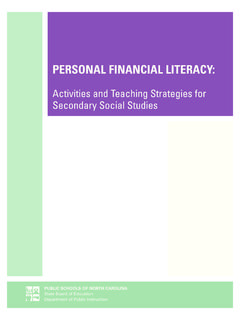Transcription of Renewing Our Commitment to Catholic Elementary …
1 Copyright 2005, United States Conference of Catholic Bishops, Inc. All rights Our Commitment to Catholic Elementary andSecondary Schools in the Third MillenniumIntroductionYoung people are a valued treasure and the future leaders of our Church. It is the responsibilityof the entire Catholic community bishops, priests, deacons, religious, and laity to continue tostrive towards the goal of making our Catholic Elementary and secondary schools available,accessible, and affordable to all Catholic parents and their children, including those who are poorand middle class. All Catholics must join together in efforts to ensure that Catholic schools haveadministrators and teachers who are prepared to provide an exceptional educational experiencefor young people one that is both truly Catholic and of the highest academic 1990, the Catholic bishops of the United States issued the statement In Support of CatholicElementary and secondary Schools.
2 In it we affirmed our strong conviction that Catholicelementary and secondary schools are of great value to our Church and our nation; and that, inour role as chief teachers, we are each responsible for the total educational ministry of the localChurch. We affirmed that the entire ecclesial community .. is called to value ever more deeplythe importance of this task and mission, and to continue to give it full and enthusiastic support. These Catholic schools afford the fullest and best opportunity to realize the fourfold purpose ofChristian education, namely to provide an atmosphere in which the Gospel message isproclaimed, community in Christ is experienced, service to our sisters and brothers is the norm,and thanksgiving and worship of our God is cultivated (p.)
3 2).In that statement we pointed to the great value and the many successes of Catholic schools andthe numerous challenges that they face. We unequivocally committed ourselves and the wholeCatholic community to the following set of goals: Catholic schools will continue to provide a Gospel-based education of the highestquality. Catholic schools will be available, accessible, and affordable. The bishops will launch initiatives in both the private and public sectors to securefinancial assistance for parents, the primary educators of their children, so that theycan better exercise their right to choose the best schools for their children. Catholic schools will be staffed by highly qualified administrators and teachers whowould receive just wages and benefits, as we expressed in our pastoral letterEconomic Justice for has changed in our Church and our nation in the ensuing years.
4 Catholic schools continueto be valued and successful; but they still encounter numerous challenges. The bishops haveaddressed many of the goals that we set in 1990, but much is still left to be done. Therefore, webelieve that the time has come to revisit and reaffirm our Commitment to Catholic elementaryand secondary schools as invaluable instruments in proclaiming the Good News from onegeneration to the next. This catechesis is a privileged way of initiating the hearers into thefullness of Christian life and is intimately bound up with the whole of the Church s life (Catechism of the Catholic Church, nos. 5, 7). We believe that now is the appropriate time torenew our challenge to the entire Catholic community to join in this critical endeavor.
5 We areconvinced that Catholic schools continue to be the most effective means available to the Churchfor the education of children and young people who are the future of the Church (To Teach asJesus Did, no. 118).Why We Value Our Catholic Elementary and secondary SchoolsYoung people of the third millennium must be a source of energy and leadership in our Churchand our nation. Therefore, we must provide young people with an academically rigorous anddoctrinally sound program of education and faith formation designed to strengthen their unionwith Christ and his Church. Catholic schools collaborate with parents and guardians in raisingand forming their children as families struggle with the changing and challenging cultural andmoral contexts in which they find themselves.
6 Catholic schools provide young people with soundChurch teaching through a broad-based curriculum, where faith and culture are intertwined in allareas of a school s life. By equipping our young people with a sound education, rooted in theGospel message, the Person of Jesus Christ, and rich in the cherished traditions and liturgicalpractices of our faith, we ensure that they have the foundation to live morally and uprightly inour complex modern world. This unique Catholic identity makes our Catholic Elementary andsecondary schools schools for the human person and allows them to fill a critical role in thefuture life of our Church, our country, and our world ( Catholic Schools on the Threshold, no. 9).It is made abundantly clear in an unbroken list of statements, from the documents of the SecondVatican Council to Pope John Paul II s 1999 exhortation The Church in America (Ecclesia inAmerica), that Catholic schools play a vital role in the evangelizing mission of the Church.
7 Theyarethe privileged environment in which Christian education is carried out .. Catholicschools are at once places of evangelization, of complete formation, of inculturation, ofapprenticeship in a lively dialogue between young people of different religions and socialbackgrounds. ( Catholic Schools on the Threshold of the Third Millennium, no. 11) Catholic schools are often the Church s most effective contribution to those families who arepoor and disadvantaged, especially in poor inner city neighborhoods and rural areas. Catholicschools cultivate healthy interaction among the increasingly diverse populations of our cities and rural areas, Catholic schools are often the only opportunity for economicallydisadvantaged young people to receive an education of quality that speaks to the development ofthe whole person.
8 As we continue to address the many and varied needs of our nation s newimmigrant population, the Church and its schools are often among the few institutions providingimmigrants and newcomers with a sense of welcome, dignity, community, and connection withtheir spiritual important as a sound Catholic school education is for the new immigrant and the poor, itcontinues to be of prime importance to those children and grandchildren of the generations whoearlier came to our shores. Our Catholic schools have produced countless numbers of well-educated and moral citizens who are leaders in our civic and ecclesial communities. We mustwork with all parents so they have the choice of an education that no other school cansupply excellent academics imparted in the context of Catholic teaching and Schools TodayOverview Since 1990 The National Catholic Educational Association s annual statistical report shows that there arecurrently 7,799 Catholic Elementary and secondary schools in the United States, which enrollover million students.
9 These schools currently account for almost 30 percent of all privateand religious schools in the United States and enroll over 48 percent of the students in theseschools. Since 1990, the Church in the United States has opened more than 400 new , there has been a net decline of more than 850 Catholic schools in the country duringthe same period of time. Almost all of this loss has been in urban, inner-city, and rural areas ofour nation. In the last decade of the twentieth century, Catholic schools experienced a period ofgrowth in enrollments. Since the year 2000, however, that trend slowed, then reversed, and nowshows a net loss of over 170,000 , there are more than 2,500 Catholic schools in the country with waiting lists. Almostall of these schools are located in suburban areas.
10 Twenty-six percent of current students inCatholic schools are members of minority groups a figure that is steadily growing. Theenrollment of students who are not Catholic has grown to percent. Staffing trends inCatholic Elementary and secondary schools show a steady increase in the number of lay peoplewho are administrators and teachers (currently 95 percent). Since 1990, the average tuition inboth Elementary and secondary Catholic schools has more than doubled; in that same time, theportion of the total cost of educating a student which parents pay in tuition has risen by almost Good NewsWe, the Catholic bishops of the United States, wish to offer our deep gratitude to thoseindividuals who staff our Catholic Elementary and secondary schools, the dedicated lay andreligious administrators and teachers.
